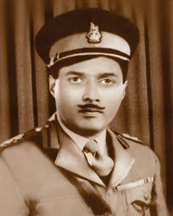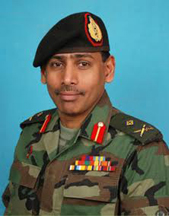From path breakers to professionals
Sri Lanka Army Volunteer Force celebrates 135 years
of growth:
by Dhaneshi Yatawara
The Army's pioneer wing, the Sri Lanka Army Volunteer Force (SLAVF),
turns a grand old 135 years, notching many landmark moments that have
seen a bunch of wannabe military guys moulding themselves into a
professional body that is very much part of the Sri Lanka Army today.
And they continue to evolve, seeing themselves being transformed into
knowledge based, technology driven, gender unbiased force in the near
horizon.
|

Col. H W G Wijekoon - Voluntary Force first Commandant. |

Maj Gen Channa Goonetilleke
|
The SLAVF heading towards professionalism targeting the best among
the younger generation to serve the country, says SLAVF Commandant,
Major General Channa Goonetilleke, explaining that the need for a wide
range of expertise, for the Volunteers to stand up among the best
servers to the nation, is a top priority. "The 135th Anniversary will be
celebrated as an 'Investment for Tomorrow'' for the benefit of the
society, Army and the Volunteer Force," he adds.
The precursor to the Volunteer Force was a mere rifle club in the
colonial period later converted into the Ceylon Light Infantry
Volunteers on April 01, 1881. Historical chronicles available with the
SLAVF state that the transformation was based on a proclamation issued
by the Lieutenant Governor Sir John Douglas in the government gazette of
April 1, 1881.
As history records, thirteen days later, Lieutenant Colonel John
Scott Armitage was appointed as the Commanding Officer. In recognition
of the Ceylon Light Infantry Volunteers (CLIV), the Prince of Wales (The
Late King Edward VII) had accepted the Honorary Colonelcy of the
Regiment and permitted the use of his motto 'Ich Dien' and his personal
insignia by the Regiment.
As the ranks got filled up over time, the CLIV raised several
companies in the main towns of the country. A valuable adjunct was the
formation of a Cadet Battalion to encourage the military movement in
schools, which developed later into the Ceylon Cadet Battalion and
finally as the National Cadet Corps.
"The Volunteers have a very elite history where our some esteemed
members of the Force, were historical figures who lead the country,"
claims Maj. Gen. Goonetilleke, explaining that it is still the main fact
that hold the high spirit of soldiering and keeping to the finest forms.
If the success of an organisation is measured in terms of its
contributions to society, then the Volunteers have reached veritable
heights with contributions made by many of its esteemed members, giving
leadership to the country. To name a few, the first Prime Minister of
Sri Lanka, D.S. Senanayake, was an active member of the Volunteer
Artillery, former Prime Minister, General Sir John Kotelawala, was from
the Ceylon Light Infantry Volunteers, education Minister of the Sri
Lanka's first Cabinet, Major E.A. Nugawela, was an active member of the
Ceylon Light Infantry Volunteers. Adding more to the list, is the first
Commanding Officer of the third (Volunteer) Battalion, the Gemunu Watch,
Colonel C.A. Dharmapala, who served the country as a Member of
Parliament and later as the Secretary of the Ministry of Defence and
Security Advisor to the President from 1977-1979.
Former minister of Parliamentary Affairs and Plantations, Major
Montague Jayawickrama, and former Labour Minister, Capt C.P.J
Senevirathne (1977-1983), were active members of the Ceylon Volunteer
Light Infantry and Ceylon Cadet Corps respectively. Deputy Minister of
Defence from 1989 - 1992, General Ranjan Wijeratne, was also a noted
officer in the Volunteers who restored the Planters' Rifle Corps.
|

New professionals training volunteers |
Evolution of the Volunteers included turning points such as the South
African War (1899- 1902), formation of Ceylon Defence Force (1910-1939),
World War II (1939 - 1945). In 1910 the Ceylon Defence Force was raised
under Ordinance No. 8 of 1910, which comprised all volunteer units.
The Volunteer Force was heavily used during the 'Hartal' of 1953. But
it recorded its first casualty during the 1971 uprising, when Senior
Sergeant Jothipala of the second Volunteer Sinha Regiment was killed in
action at Thulhiriya on 05 April 1971. The Volunteers were mobilised for
internal security during the uprising.
Volunteer Battalions were also tasked with 'Task Force Anti-Illicit
Immigration' from 1964 onwards. During the 1971 insurrection, a new
regiment was raised to meet the additional requirement of man-power.
This was the National Service Regiment, which was subsequently disbanded
and most Officers and soldiers absorbed into other Volunteer Units.
In 1972, Battalion became officially known as the Sri Lanka Army
Volunteer Force as Sri Lanka became a republic on May 22 of that year.
With the upsurge of violence in 1983, consequent to the killing of 13
Sri Lanka Army personnel in the North and with the failed political
settlement in 1994, the Volunteer Force has been called out to active
duty and has remained in active duty since then.
"The SLAVF was not confined to secure reclaimed lands during the war
but were active in the battles," explains Maj. Gen. Goonetilleke,
elaborating that today the SLAVF is a mega institute with 2898 officers
and 68,449 other ranks belonging to 101 battalions.
In diversifying their capacities, the SLAVF is focusing on areas such
as sports as it is one of their strongest points at the national level,
armed with talented personnel in par with the international standards.
The trend of the world is to form a volunteer reserve of
professionals who will be called out for duty as required. "In the post
war era, to be an effective part of developing the national economy,
SLAVF need to convert themselves towards more professionalism,"
emphasises Maj. Gen. Goonetilleke.
The SLAVF master plan is not only rope in new recruits, but convert
the existing human resource to expertise in their respective fields,
while in service and post retirement. "The benefit our men and women
have is that years before their retirement they get an opportunity to be
ready for new employment. And we are not targeting commercial security.
They will be trained and skilled to suit supervisory to middle and
higher level management opportunities," he says, explaining that in a
job market where there is a dearth of suitable professionals against the
demand, the volunteer men and women will have a better chance
considering their professional background.
In their attempts to strengthen the Volunteers, Maj .Gen.
Goonetilleke says the most important facts considered, for both in
service and new recruits are high professionalism and capability and not
gender, ethnicity or religion. "Just like the Sri Lanka Army, we are an
equal opportunity institute," he adds. |

